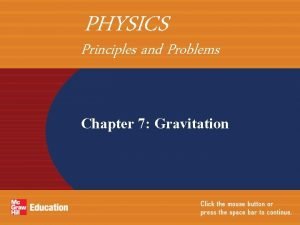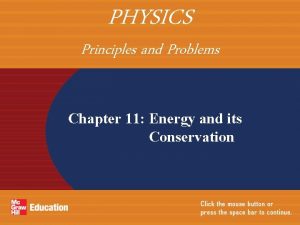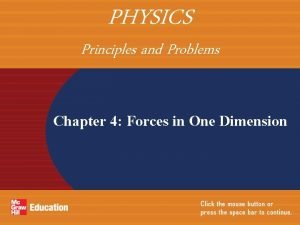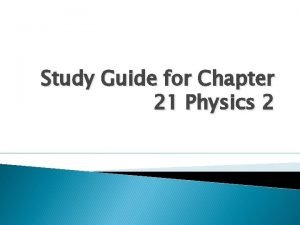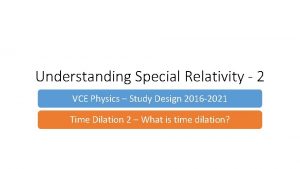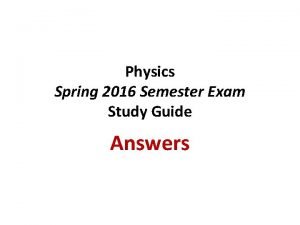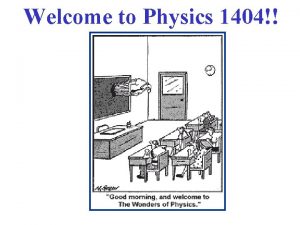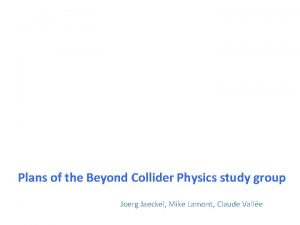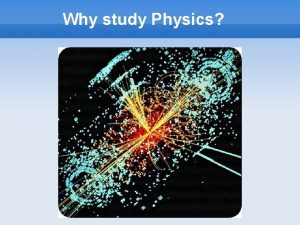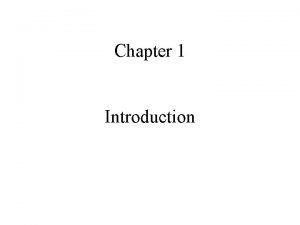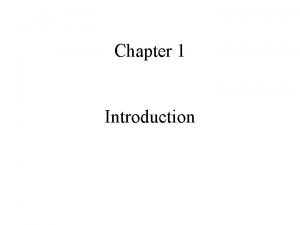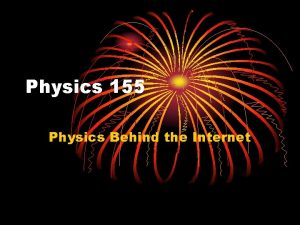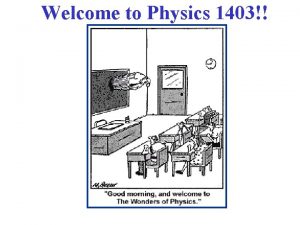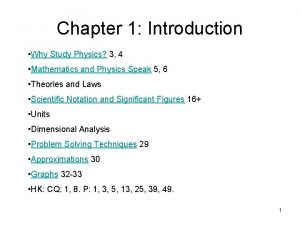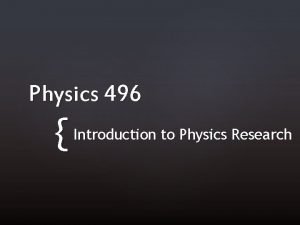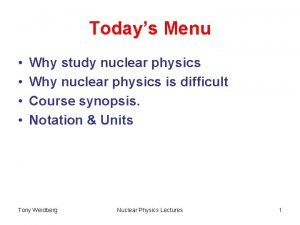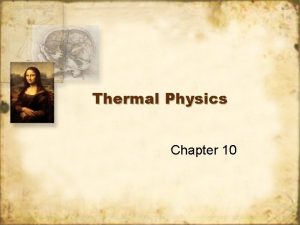Chapter 1 Introduction Why Study Physics 3 4

















- Slides: 17

Chapter 1: Introduction • Why Study Physics? 3, 4 • Mathematics and Physics Speak 5, 6 • Theories and Laws • Scientific Notation and Significant Figures 16+ • Units • Dimensional Analysis • Problem Solving Techniques 29 • Approximations 30 • Graphs 32 -33 • HK: CQ: 1, 8. P: 1, 3, 5, 13, 25, 39, 49. 1

Scientific Theory • A model for explaining phenomena that is simple yet predicts a broad range. • Criterion: • Testable • Accurate (not perfect) 2

Law • A scientific law is a statement describing natural behavior which has a history of scientific replication. • Law = describing • Theory = explaining • Describing is easier than explaining! Laws usually come first. • E. g. Boyle’s Law (1662), Bernoulli’s Kinetic Theory of gases (1740). 3

SI Base Units • meter (m) • kilogram (kg) • second (s, sec) • • ampere (A) kelvin (K) mole (mol) candela (cd) 4

Prefixes for SI Units • • • convenient shorthand for powers of 10 examples: m = 10 -3 e. g. millimeter c = 10 -2 e. g. centimeter k = 103 e. g. kilometer 5

Other Common Units • • foot: mile: hour: / 3. 28 ft = 1 m 1 mi = 1609 m 1 h = 3600 s 6

Significant Figures (s. f. ) • trailing 0’s count, e. g. 1. 560 • leading 0’s not counted, e. g. 0. 01 • more s. f. implies more precision 1. 560 1. 056 3 s. f. 4 s. f. 12. 001 0. 0010 5 s. f. 1 s. f. 2 s. f. 7

Calculating with Significant Figures 8

Unit Analysis • • • calculation and comparison of units Given: v = at [v] = m/s [t] = s [v] = [a][t] m/s = [a]s [a] = m/s/s 9

Dimensional Analysis • • units replaced by “dimensions” e. g. meter = L, seconds = T unit-independent e. g. [velocity] = L/T 10

Converting Units 11

Problem Solving • • write key data as you read mark unknowns with “? ” double check each value use SI values, e. g. 5 cm 0. 05 m sketch physical situation write equations solve, consider, read question again 12

Summary • • Unit and Dimensional Analysis Metric Prefixes -9 to +9 Unit Conversions Problem Solving 13

14

15

Significant Figures (s. f. ) • estimate of measurement precision • trailing 0’s count (3. 00) • leading 0’s not counted (0. 004) 1. 560 1. 056 3 s. f. 4 s. f. 3. 0/1. 56 = 1. 9 3. 0000/1. 56 = 1. 92 12. 001 0. 0010 5 s. f. 1 s. f. 2 s. f. 3. 0 + 1. 56 = 4. 6 3. 0000 + 1. 56 = 4. 56 16

Common Prefixes Prefix giga mega kilo centi milli micro nano Symbol G M k c m μ n Power of 10 109 106 103 10 -2 10 -3 10 -6 10 -9 17
 Andreas carlsson bye bye bye
Andreas carlsson bye bye bye Don't ask why why why
Don't ask why why why Chapter 7 study guide gravitation
Chapter 7 study guide gravitation Chapter 11 study guide conservation of energy
Chapter 11 study guide conservation of energy Chapter 4 assessment physics
Chapter 4 assessment physics Physics chapter 2 representing motion assessment answers
Physics chapter 2 representing motion assessment answers Physics chapter 21 study guide answers
Physics chapter 21 study guide answers Physics chapter 1 introduction and mathematical concepts
Physics chapter 1 introduction and mathematical concepts Why study financial institutions
Why study financial institutions Why does it happen
Why does it happen University physics with modern physics fifteenth edition
University physics with modern physics fifteenth edition Ib physics ia samples
Ib physics ia samples Physics study design
Physics study design Physics semester 1 final exam study guide answers
Physics semester 1 final exam study guide answers Webassign ttu
Webassign ttu Physics study group
Physics study group Vcaa scientific poster template
Vcaa scientific poster template Why do boxers wear gloves physics
Why do boxers wear gloves physics


